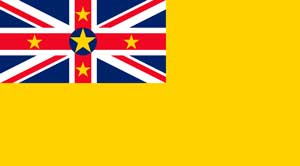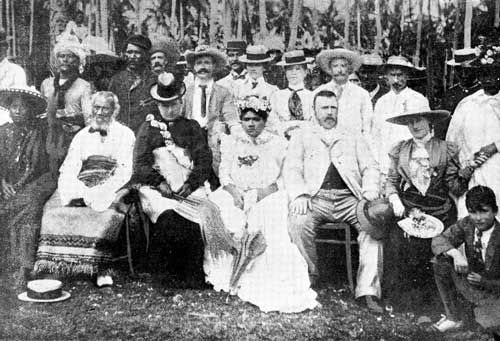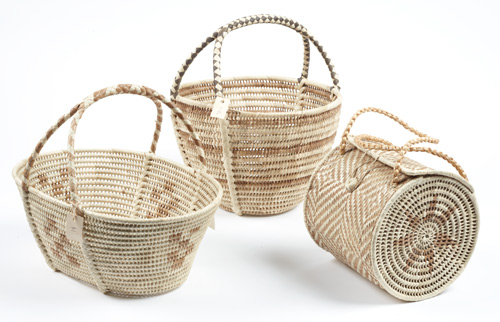Map
Flag

Quick facts
Official Name: Niue
Indigenous Peoples: Niueans, Polynesians
Official Languages: Niuean
Political Status: Free association with New Zealand, New Zealand citizens
Capital: Alofi
Population: 1,190 (2014 est.)
Greeting: Fakaalofa lahi atu
History and geography

Niue, off the coast of Tonga, is one of the world’s largest coral islands. With a landmass of 259 sq km, it lies about 2,400 km northeast of New Zealand. The terrain consists of steep limestone cliffs along the coast with a central plateau rising to about 60 meters (180 feet) above sea level. A coral reef surrounds the island, with the only major break in the reef being in the central western coast, close to the capital, Alofi. A notable feature is the number of limestone caves found close to the coast.
Oral tradition speaks of the first settlement of Niue by Huanaki and Fao, and the Fire Gods from Fonuagalo, the hidden land. Archeologists believe the island was settled about 2,000 years ago by two waves of migration, one from Samoa and the other from Tonga, with a smaller migration from Pukapuka in the Cook Islands.
Until the beginning of the 18th century, chiefs and heads of families exercised authority over the population. Around 1700, the concept and practice of kingship appears to have been introduced through contact with Samoa or Tonga. A succession of patu-iki (kings) ruled, the first of whom was Puni-mata. Tui-toga, who reigned from 1875 to 1887, and was the first Christian king.
The first European to sight Niue was Captain James Cook in 1774. He made three attempts to land, but was refused permission to do so by the inhabitants. He named the island “Savage Island” (Niue fekai) because, as legend has it, the natives who “greeted” him were painted in what appeared to be blood. The substance on their teeth was hulahula, a native red banana.
For the next couple of centuries, Niue was known as Savage Island until its original name, Niuē, which translates as, “behold the coconut,” regained use. It is also commonly called “the Rock of Polynesia.”
The island was visited by Captain John Erskine aboard the HMS Havannah in July 1849. Christian missionaries from the London Missionary Society unsuccessfully tried to set up a mission as early as 1830, but later arrived in 1846, with a Niuean missionary, Peniamina, who had trained at the LMS school in Samoa, and a Samoan missionary named Paulo. English missionary Reverend William Lawes arrived in 1861. The LMS set up the Ekalesia Niue (Christian Church of Niue). Between 1846 and 1890, missionaries formalized the alphabet and translated the Bible (Ko e Tohi Tapu) and a hymn book (Ko e Tau Lologo Tapu).
In 1862, Peruvian slave ships kidnapped 109 islanders to work guano mines and plantations back in Peru.
In 1889, the chiefs and rulers of Niue, in a letter to Queen Victoria, asked her “to stretch out towards us your mighty hand, that Niue may hide herself in it and be safe.” After expressing anxiety lest some other nation should take possession of the island, the letter continued: “We leave it with you to do as seems best to you. If you send the flag of Britain that is well; or if you send a Commissioner to reside among us, that will be well.” The offer was not initially taken up by the British. In 1900, a petition by the Cook Islanders asking for annexation included Niue “if possible,” but this was unacceptable to the Niueans.
In a 1901 document, the “King” and Chiefs of Niue consented to “Queen Victoria taking possession of the island.” A dispatch to the Secretary of State for the Colonies from the Governor of New Zealand referred to the views expressed by the Chiefs in favor of “annexation” and to this document as “the deed of cession.” A British protectorate was declared, but it was short-lived. Niue was brought within the boundaries of New Zealand in 1901 for services during the South African War, by the same Order and Proclamation as the Cook Islands.
New Zealand rule, however, was frustrating to the islanders, because of petty laws such as curfews and alcohol bans. New Zealand, however, was also seen as a land of opportunity, and many islanders migrated out to Niu Silani. Some 150 Niuean troops served during the World War I, and over the next two decades even more Niueans moved to New Zealand.
Self-government was granted by the New Zealand parliament with the 1974 constitution, following a referendum in 1974 whereby Niueans were given three options: independence, self-government or continuation as a New Zealand territory. The majority selected self-government, and Niue’s written constitution was promulgated as supreme law. Robert Rex, ethnically part European, part native, was appointed the first premier, a position he held until his death 18 years later. Rex was the first Niuean to receive a knighthood (1984).
There is a small tourism market in Niue, and subsistence agriculture sustains the economy. Farmers have recently turned to organic farming for lucrative profits in New Zealand. New Zealand provides strong financial support to Niue. Top exports include canned coconut cream, copra, honey, passion fruit products, root crops, stamps and handicrafts.
Arts and culture

Niuean islanders live throughout 14 villages, enjoying dual citizenship with New Zealand. As with other Pacific nations, Niueans are deeply Christian. Niuean women are renowned for their artistry and skill at weaving bags, hats and other adornments, often incorporating new materials such as plastic beads and nylon.
Other cultural items produced by Niueans historically included katoua (clubs), lei (necklaces), tao (spears), hiapo (tapa cloth), tiputa (ponchos), potu (mats) and maka (throwing stones). Other accessories included kafa lauulu, or belts of human hair, traditionally worn by warriors as a sign of social status. The textiles (tekesitaila) in Niue reflect changes through history, especially brought about by contact with Samoan culture through the missionization of the island. Pandanus mats with wool fringing are an example of this contact between cultures. Designs using natural dyes often depict nature and animals, as well as geometric patterns. Kato (baskets) also have distinctive designs and shapes, including woven carry handles.
The traditional vaka, or canoe, is still used to source food from the ocean. Niue vaka were typically dugouts with an outrigger attached. The vaka were used to travel to Tonga, Samoa and New Zealand.
The people speak Niuean (Niuean: ko e vagahau Niuē), which is a Polynesian language. It is most closely related to Tongan. Niuean also has a number of influences from Samoan and Eastern Polynesian languages.
Musical traditions include songs, usually performed without instrumental accompaniment. However, there are wooden drums called palau, or nafa, made from the carved trunk of the selie tree, that sometimes are used to provide rhythm.
